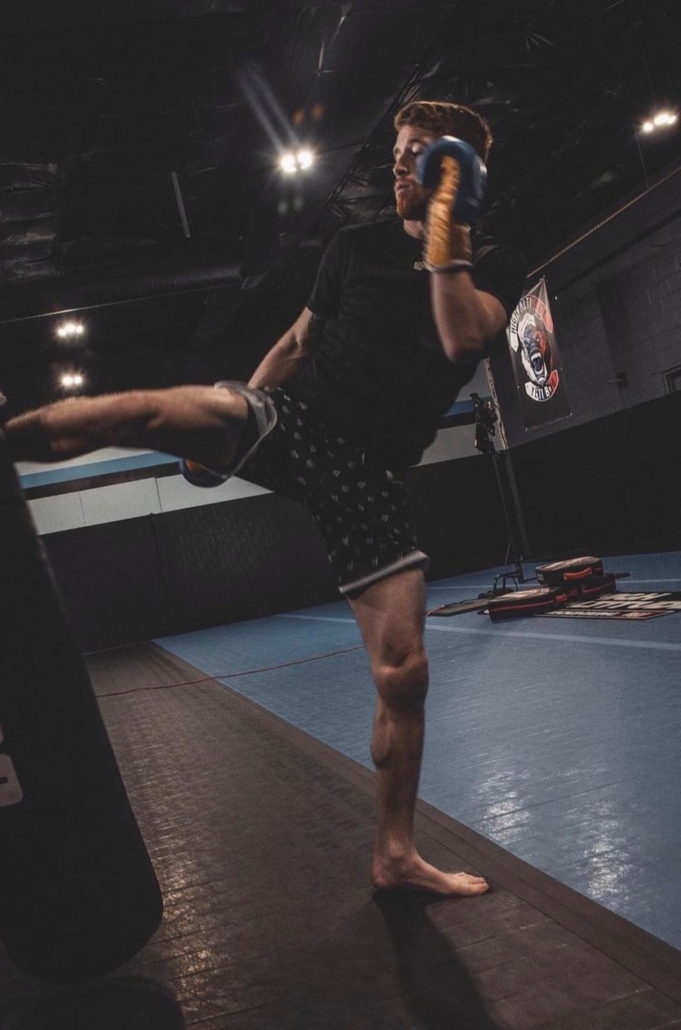We get this question a lot. Short answer, your target, whether in class, in competition, or in a real life self defense situation, does not stay stationary. Training yourself to hit something that doesn’t move is how the High Altitude School of Striking curriculum was built.
Heavy bags are among one of the most common pieces of equipment in martial arts gyms. Boxers, kickboxers, and mixed martial artists all use them for training. While heavy bags may be beneficial to developing power, they can be detrimental to technique. A fighters reaction speed, spacial awareness, and precision can decrease if they overuse a heavy bag.
Eyes:
-Fighters train their eyes to react to movement. Fighters with well trained eyes can defend a strike and already be countering by the time the blow lands.
-This skill of reaction requires sharp perception of movement. It’s developed by tech sparring or doing pad work.
-Heavy bags don’t offer counterattacks or movement that a person does.
-Bags have limited movement, and the movement it does have is very linear.
-They swing back and forth in a circle.
-There’s nothing coming out from the bottom, top, or side of the bag for the fighter to react to.
Range:
-As mentioned before, the movement of the heavy bag isn’t very conducive to the technique of fighters.
-Especially when a fighter is trying to learn their range, bags don’t move with the fighter, they move independently and without control.
-The distance between the fighter and the bag varies at an unhelpful pace. Moving with a partner helps the fighter establish range without having their “opponent” swinging in and our of range constantly.
– Alternatively, if a bag is stationary, not hanging, or tied at both ends, there will be little to no movement for the fighter to react to.
-This could create long-term habits of staying stationary and using no head movement or footwork.
-Fighters are trained to and naturally mirror their opponents for both offensive and defensive reasons. If their “opponent” doesn’t move much in training, they’ll struggle to move with a real opponent in sparring or competition.

Defense:
-While many techniques are negatively impacted by the use of a heavy bag, defense is not even an option.
-The bag cannot attack or throw any sort of strike. There are no ways to use heavy bags for defense training, which means martial artists will be lacking a crucial part of the sport.
– Everyone knows the best offense is a good defense, and the limitations bags put on fighters for defense are nothing short of detrimental.
-Some may argue the movement of the bag can help for pivoting and cutting angles with footwork. This would be true if the bag didn’t swing right back to where it was before the pivot or angle cut.
-The lack of variety or control in the movement of the heavy bags makes it impossible to use for defensive training.
Speed:
-Nothing about heavy bags require or encourage speed in one’s strikes.
-Most people who wail on the bag go for slow and hard strikes. While power is important, it means nothing if it’s not accompanied by speed.
– Heavy bags move slowly and are meant to take a big hit. This results in people using the heavy bag to build power and forget speed.
– A powerful punch means nothing if it won’t land on your opponent.
-Speed is crucial to martial arts training, and can be developed from training with another person and/or a speed bag, but heavy bags just don’t make the cut.
Precision:
-Training on a heavy bag doesn’t help a fighter’s precision. Since the bag is all one shape, it’s hard to tell where a punch or kick would land on a real person.
– Someone practicing body shots on the heavy bag may be striking way too low, hitting where a person’s hip would be, just because it’s the middle of the bag.
-Imagining where a person’s face is does nothing for the accuracy of the fighter.
– Most people’s heads are around six inches wide. Bags can be 8 to 12 inches wide, so some punches that land on the bag may completely miss an opponent.
– In the same way, a leg kick on a heavy bag is just anywhere in the lower area of the bag. This lower area on a heavy bag can be a whole foot of vertical range.
-But in sparring and competition, leg kicks are meant to land in a 3 inch space just above the knee.
– It’s difficult and near impossible to develop the necessary precision that each fighter needs on a heavy bag.

None of this means that heavy bags are bad or that they shouldn’t be used. Heavy bags have many useful purposes. They’re great for power and cardio workouts where precision and technique aren’t the focus. It’s important to know which training style/piece of equipment is appropriate for the skills one is wanting to work on. Next time you work on the heavy bag ask yourself, “Does the workout I’m doing match the equipment I’m using?” It’s always good to mix up your routine and stop in to open mat to get some good cardio on our bags. It’s also great for practices those spinning/flying moves. We encourage heavy bag usage, we just don’t use them in class.





